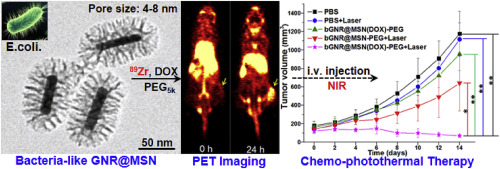Biomaterials ( IF 12.8 ) Pub Date : 2018-02-23 , DOI: 10.1016/j.biomaterials.2018.02.043 Cheng Xu , Feng Chen , Hector F. Valdovinos , Dawei Jiang , Shreya Goel , Bo Yu , Haiyan Sun , Todd E. Barnhart , James J. Moon , Weibo Cai

|
Mesoporous silica nanoshell (MSN) coating has been demonstrated as a versatile surface modification strategy for various kinds of inorganic functional nanoparticles, such as gold nanorods (GNRs), to achieve not only improved nanoparticle stability but also concomitant drug loading capability. However, limited drug loading capacity and low tumor accumulation rate in vivo are two major challenges for the biomedical applications of MSN-coated GNRs (GNR@MSN). In this study, by coating uniformly sized GNRs with MSN in an oil-water biphase reaction system, we have successfully synthesized a new bacteria-like GNR@MSN (i.e., bGNR@MSN) with a significantly enlarged pore size (4–8 nm) and surface area (470 m2/g). After PEGylation and highly efficient loading of doxorubicin (DOX, 40.9%, w/w), bGNR@MSN were used for positron emission tomography (PET, via facile and chelator-free 89Zr-labeling) and photoacoustic imaging-guided chemo-photothermal cancer therapy in vivo. PET imaging showed that 89Zr-labeled bGNR@MSN(DOX)-PEG can passively target to the 4T1 murine breast cancer-bearing mice with high efficiency (∼10 %ID/g), based on enhanced permeability and retention effect. Significantly enhanced chemo-photothermal combination therapy was also achieved due to excellent photothermal effect and near-infrared-light-triggered drug release by bGNR@MSN(DOX)-PEG at the tumor site. The promising results indicate great potential of bGNR@MSN-PEG nanoplatforms for future cancer diagnosis and therapy.
中文翻译:

用于正电子发射断层扫描和光声成像引导的化学光热联合治疗的细菌样介孔二氧化硅包被的金纳米棒
介孔二氧化硅纳米壳(MSN)涂层已被证明是一种用于多种无机功能纳米颗粒(如金纳米棒(GNRs))的通用表面改性策略,不仅可以提高纳米颗粒的稳定性,而且还可以实现相应的载药能力。然而,有限的药物载量和体内低的肿瘤蓄积率是MSN涂层GNRs(GNR @ MSN)在生物医学应用中的两个主要挑战。在这项研究中,通过在油水双相反应系统中用MSN包被大小均一的GNR,我们已经成功合成了一种新的细菌样GNR @ MSN(即bGNR @ MSN),其孔径显着增大(4–8 nm) )和表面积(470 m 2/G)。经过聚乙二醇化和高效负载阿霉素(DOX,40.9%,w / w)后,bGNR @ MSN用于正电子发射断层显像(PET,通过简便且无螯合剂的89 Zr标记)和光声成像引导的化学光热体内癌症治疗。PET成像显示89Zr标记的bGNR @ MSN(DOX)-PEG可以被动地靶向4T1鼠类乳腺癌小鼠,效率高(约10%ID / g),这是基于增强的通透性和保留效果。由于出色的光热效应和bGNR @ MSN(DOX)-PEG在肿瘤部位释放的近红外光触发的药物释放,还实现了显着增强的化学-光热联合疗法。令人鼓舞的结果表明bGNR @ MSN-PEG纳米平台在未来癌症诊断和治疗中具有巨大潜力。







































 京公网安备 11010802027423号
京公网安备 11010802027423号